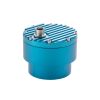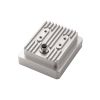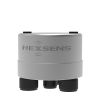Geolux Non-Contact Flow Sensors
Features
- Contactless water level and surface velocity measurement
- Integrated discharge (flow) calculation
- RS-232, RS-485 Modbus, SDI-12, analog 4-20 mA interfaces in all models
- Free ground shipping
- Expedited repair and warranty service
- Lifetime technical support
- More
Oerview
The Geolux Non-Contact Flow Sensor has an integrated radar surface velocity and level sensor for contactless velocity, level, and discharge (flow) measurements.
Mechanics
Contactless radar technology enables quick and simple sensor installation above the water surface with minimum maintenance. Calculation of the total flow discharge is internally implemented within the instrument by combining surface velocity measurement, water level measurement, and a configured cross-section of the river or channel. Defining the measurement parameters such as profile cross-section, material of the edges, location of the sensor above the water, and all other instrument settings can be easily set with the Geolux configuration application using any available communication interface.
General Specifications
Detection Distance: 15m / 30m / 50m
Speed Range: 0.02m/s to 15m/s
Speed Resolution: 0.001m/s
Speed Accuracy: 1%
Level Resolution: 0.5mm
Level Accuracy: +/-2mm
IP Rating: IP68
Electrical & Mechanical
Input Voltage: 9 to 27 VDC
Power Consumption: 1,3 W operational; 0,235 W standby
Maximal Current: < 750 mA
Temperature Range: -40 °C to +85 °C (without heating or coolers)
Enclosure Dimensions: 150mm x 200mm x 250mm
Weight: 3.08kg
Interface
Serial Interface: 1 x serial RS-485 half-duplex; 1 x serial RS-232 (two wire interface)
Baud Rate: 9600 bps to 115200 bps
Serial Protocols: Modbus, GLX-NMEA
Other Protocols: SDI-12
Analog Output: 4-20 mA, programmable velocity, level or flow
Certificates
EN 61326-1:2013
ETSI EN 301 489-1
ETSI EN 301 489-3
EN 301 489-3 V2.1.1:2019
EN 301 489-1 V2.2.3:2019
EN 300 440 V2.2.1:2018
EN 62368-1:2014+A11:2007;
EN 60950-22:2017
EN 61010-1:2010
FCC Part 15 class B
ISED RSS211
In The News
From Paddles to Phytoplankton: Studying Vermont’s Wildest Lakes
For six months of the year, Rachel Cray, a third-year PhD student at the Vermont Limnology Laboratory at the University of Vermont, lives between a microscope and her laptop, running data. For the other six months, she is hiking and canoeing four of Vermont’s lakes, collecting bi-weekly water samples. Cray studies algal phenology across four lakes in Vermont, US, that have low anthropogenic stress—or in other words, are very remote. Funded by the National Science Foundation Career Award to Dr. Mindy Morales, the lakes Cray researches part of the Vermont Sentinel Lakes Program, which studies 13 lakes in the area and, in turn, feeds into the Regional Monitoring Network, which operates in the Northeast and Midwest US.
Read MoreReimagining Water Filtration: How Monitoring and Science Enhance FloWater Filtration Systems
Over 50% of Americans think their tap water is unsafe , according to the Environmental Working Group (EWG). Other recent surveys have found that number to be as high as 70% of persons surveyed. Whether due to increased public awareness of water quality issues or confusion about how municipal water sources are regulated, there is a clear distrust of tap water in the United States. According to industry expert Rich Razgaitis, CEO and co-founder of the water purification company FloWater, this issue creates a damaging cycle. Razgaitis explained that the health and environmental problems associated with contaminated water aren’t the only issues. As people become increasingly aware that some tap water is unsafe, they resort to bottled water.
Read MoreMonitoring New Hampshire’s Aquatic Ecosystems: Continuous Data Collection in the Lamprey River Watershed
New Hampshire’s aquatic ecosystems provide a range of ecosystem services to the state and region. Resources and services like clean water, carbon storage, climate regulation, nutrient regulation, and opportunities for recreation all depend on New Hampshire’s aquatic ecosystems remaining healthy. Jody Potter, an analytical instrumentation scientist at the University of New Hampshire (UNH), is studying these aquatic ecosystems in hopes of developing an improved understanding of ecosystem services and their interactions with climate change, climate variability, and land use changes. [caption id="attachment_39799" align="alignnone" width="940"] Aquatic sensors in the Merrimack River in Bedford, NH, with I-293 in the background.
Read More













